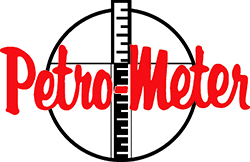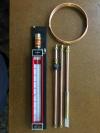Why is a Model 1329 a good choice for a tank gauge?

Why is a Model 1329 a good choice for a tank gauge?
Petro-Meter has been manufacturing the Model 1329 tank gauge for almost 100 years and the reason this product has been so successful is its sheer simplicity. Among the many different approaches to remote tank level monitoring the hydrostatic principle has always offered attractive advantages against competing methods:
The system requires no external power source or air supply and is completely self-contained.
The instrument has no moving parts that will wear down or hang up as mechanical systems often do. By virtue of this fact it is virtually maintenance free.
The system can report level readings accurately and reliably at distances of up to 100’.
The system can accurately report remote level readings for tank above or below grade.
As good as the Model 1329 tank gauge is, it is limited to the following tank parameters:
The indicator can only service tanks that are 100% vented to atmosphere. Considering that this instrument derives readings from sampling hydrostatic pressure within a containment vessel, should the vessel have any type of venting restriction (vapor pressure vents, flame arrestors, etc.), the instrument will not be able to differential liquid head pressure from added gas pressure due to the lack of a proper vent. This is usually more of an issue with tanks that contain flammable liquids such as gasoline, ethanol or similar petroleum or alcohol derivatives. Although the Model 1329 tank gauge cannot overcome this limiting parameter, we can however offer our industrial tank gauge equivalent, the Model 1700-6 hand-pump operated tank gauge. This instrument works on the same principles as the Model 1329 yet offers the possibility of being used as a differential pressure reading instrument. In short, a Model 1700-6 utilizing two separate sensing lines can accurately report remote tank level readings in tanks that are not vented by sampling the overall pressure at the bottom of the vessel (head pressure + gas pressure) and subtracting the gas pressure from this total utilizing an “equalizing” line, or a line that samples gas pressure from above the surface of the stored liquid and is applied against the overall pressure leaving only the hydrostatic liquid pressure as a reading.
Additionally, the Series 1700 industrial tank gauge line can incorporate existing plant compressed air and utilize it as a means for obtaining hydrostatic level readings without the necessity of pumping it manually as the Model 1329 requires. In short, the Model 1329 tank gauge is always an excellent choice for heating oil applications or diesel tanks since these tanks are commonly vented to atmosphere and generally within the dimensional range of 1329s. Non-vented tanks or tanks with extreme dimensional attributes (tall vertical tanks) can usually be handled with a Series 1700 indicator specific for the application.
Another consideration for selecting a proper gauge is the preferred mounting area for the instrument. The Model 1329 tank gauge is NOT a weatherproof instrument and standard TYPES will freeze should the ambient temperate of the gauge’s installation site descend below 32º F. For this reason, it’s important to consider that the nature of this gauge is to take level readings remotely and if that final mounting spot can be in a heated, indoor area then there is little to be concerned about. If on the other hand the device needs to be installed in an unheated shed or garage, then a non-freezing TYPE “A” instrument should be selected. All this means is that indicating liquid within the instrument will be non-
freezing and operational in extreme temperatures as low as -40º F. The proper sizing chart should be used when sizing non-freezing Type “A” gauges as these instruments will tend to be longer than their standard counterparts.
Last but not least, should the application require a Model 1329 to be mounted outdoors then a non-freezing gauge should be considered unless the installation is in a tropical region, and a suitable weatherproof enclosure should be used to protect it from the elements. A Model 1329 tank gauge pre-built into an enclosure of this type is called a Model 1527 and is available in standard and non-freezing types.
When selecting a Petro-Meter tank gauge for an application the specific gravity of the fluid being gauge is of utmost importance as these instruments rely on hydrostatic pressure to derive a level reading and this pressure is determined by the height of the liquid and its specific gravity. Most common hydrocarbon fuels have tabulated values that may oscillate slightly from formulation to formulation. Temperature is also a factor but for the purpose of bulk level readings as our instruments are used for these factors are very small and consequently negligible. Petro-Meter typically furnishes paper scales that are graphically calibrated to represent accurate level heights for No.2 Fuel Oil or Diesel as well as No.4 Fuel Oil. Additional pre-printed scales are available for Kerosene, Water and Gasoline (in vented tanks only) as needed and ultimately we can custom generate a scale for any liquid that it is needed for as long as the specific gravity can be supplied.
Tank volume readings printed on the same readout scale are always useful to the operator avoiding the need to translate a reading from inches to gallons by referring to a lookup chart or table elsewhere. These gallon figures can be calculated and represented at the correct scale heights by Petro-Meter if accurate tank dimensions can be made available to us. In horizontal storage tanks this would generally be tank diameter, tank length and tank end configuration (whether the ends of tank are flat or dished our beyond the cylinder weld). The higher the grade of accuracy in tank dimensions supplied for the calibration of a gallon scale the higher the accuracy in the reading once obtained. Rectangular or square tanks can be computed according to height, length and width and vertical tanks that do not surpass the maximum range of a Model 1329 can also be calculated. Tall vertical tanks should use a Series 1700 indicator.



